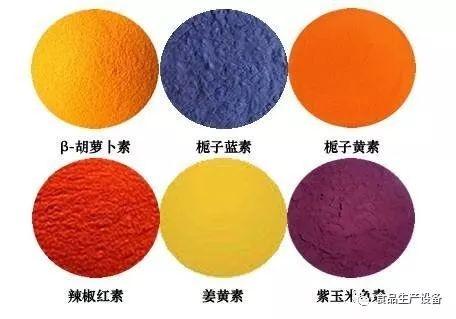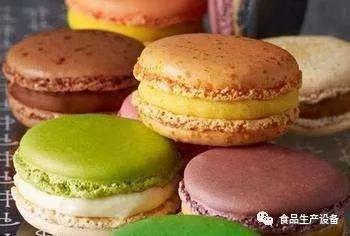Cases
Food colorants are one of the food additives that people consume almost continuously throughout their lives. It does not have to have nutritional value, but it must be non-toxic to the human body. With the continuous deepening of medical toxicology and biological experimental research work, it is found that many varieties of chemical synthetic pigments are harmful to human body, especially the carcinogenic problem found in recent years, which has attracted the attention of relevant departments in various countries.
In recent years, the research of natural plant pigments has become a hot spot and more and more in-depth, and its application in food is more and more extensive. However, not all plant pigments are non-toxic and harmless, so when developing new varieties of plant pigments, there must be sufficient scientific basis and perfect toxicology tests, and it can be applied in food after approval.
There are many pigments in nature, some of which can be used as food pigments, and many of these pigments are between yellow, orange and red. Natural pigments are divided into three categories according to their source: plant pigments. Such as 11r green pigment in green leaves (green), carotene in carrots (orange), lycopene in tomatoes (red), etc.; Animal pigments, such as heme in muscle (red), astaxanthin in shrimp shell (red), etc.; Microbial pigments. Such as soy bean curd surface monascus pigment (red) and so on.
In the development and application of natural pigments, there are more than 40 kinds of natural pigments allowed to be produced and used in China, with more than 100 production plants and an annual output of over 10,000 tons. The main variety of production and use is caramel color, the annual output accounts for about 86% of the natural food color, mainly used in the domestic brewing industry and beverage industry. Followed by red koji red, Gaoliang red, jasmine yellow radish red, copper chlorophyll sodium salt, carotene, cocoa shell color, turmeric, etc., mainly used to prepare wine, candy cooked meat products, jelly, ice cream, artificial crab meat and other food.

Application of natural pigments in food industry
At present, there are more than 40 kinds of natural pigments allowed in our country, and corresponding national standards have been formulated. There are mainly several natural pigments in food.
The main components of red yeast rice are erythemin and monascoporubin. According to the state regulations, manufacturers can use it to prepare wine, candy, cooked meat products, beancurd, ice cream, cake, jelly and other foods.
Caramel sucrose, glucose or malt syrup is caramelized at a high temperature of 160~180 ° C, and then neutralized with alkali, that is, to make a reddish-brown or black-brown paste - caramel. Because in the production of caramel, ammonium salt is sometimes used as a catalyst, which makes caramel contains 4-methylmisazole, which has a strong convulsive effect, if the amount is too large, it is harmful to the human body. Therefore, our country stipulates that the use of ammonium salt as a catalyst to make caramel is only limited to carbonated beverages, rice wine, wine, and the content of 4-methylazole can not exceed 200 mg/kg.
Purple sweet potato pigment has good heat resistance, can withstand the pasteurization temperature in the food industry, and it is less affected by metal ions and other compounds, and it is easily soluble in alcohol and water. In Japan, it is mainly used as a red to purple coloring agent for food, and is added to ice cream, dairy drinks, cheese, aquatic products, fruit juice drinks, jelly, pickled products, caramel products, cereals and other foods. Because it is a natural and non-toxic product, the amount is not restricted to meet the required color. At the same time, because purple sweet potato pigment has antioxidant, anti-mutation and other physiological effects, it can be used as a functional ingredient of health food, and has begun to be tried in liver protection nutrition health products.
Beet red is a natural pigment made from edible red beet root by extraction, separation, concentration and drying. The product is a red purple to deep purple liquid, block or powder, easily soluble in water, and the aqueous solution is red to purple, with bright color. Beet red can be used in fruit-flavored drinks (liquid, solid), fruit juice drinks, soft drinks, mixed wine, candy, pastry makeup, red and green silk, canned, juice concentrate, green plum, ice cream, ice cream, sweet jelly, waffle cookies and sandwich layer, etc., the amount of use according to the normal production needs. Beet red has good coloring for food, and because the pH value of most foods is between 3.0-7.0, and its color does not change in this pH range, it is better applied to cold food that is not affected by heat and light.
Lac red (lac red) A colored substance secreted by lac worms on their parasitic plants. Its color can change with the change of pH value, the smaller the pH value, the redder the color; The higher the pH, the more violet the color. The state stipulates that the maximum use of shellac red shall not exceed 0.5 mg kg.
Cocoa shell color is a brown pigment extracted from cocoa beans and cocoa bean skin, brown powder, odorless, with light chocolate flavor, easy to dissolve in water and dilute ethanol, heat resistance and reduction resistance are good, good staining of starch and protein, mainly used in soda, milk drinks, cola drinks and candy and other foods, the maximum use of 3 g/kg.

Gardenia yellow can inhibit the oxidation of 80% linoleic acid, so it can be used as an antioxidant in food processing. Its heat resistance is good, at 80℃, 120 minutes under the condition of pigment residual rate of more than 85%; In the range of visible light (400-700 nm), the irradiation of light is stable, while the irradiation of light in the range of wavelength 250-390 nm is unstable. Therefore, gardenia yellow pigment can be used as an antioxidant and colorant in the food industry. Gardenia yellow pigment has excellent dyeing ability for protein, starch, etc., and can be widely used in pastry, candy, flour, beverage, jelly, cookies, ice cream and other foods.
Precautions for natural pigments in the application process
The preparation of the pigment solution directly uses the pigment powder, which is not easy to distribute evenly in the food and may form color spots. It is advisable to beat with a small amount of cold water first, and then add it to the boiled solution under constant agitation. The water used should be distilled or softened to avoid pigmentation caused by calcium and magnesium ions. Containers for preparing food or storing food should be clean containers with corrosion resistance such as glass, enamel and stainless steel to avoid contact with copper and iron.
Beverage: pay attention to water quality treatment and products to avoid light, choose low water insoluble pigment to ensure the product bright and transparent, choose 85% content of pigment to ensure good stability of the product.
Emulsion essence: 85% of the product should be selected, with less impurities and good stability, and calcium stable sunset yellow should be selected to avoid calcium precipitation in the emulsion essence.
Candy: Be careful to add color late, preferably after the sugar is boiled, and add flavor at the same time.
Dairy products: Try to choose 85% products to reduce the adverse effects of salt contained in the pigment on dairy products.
Baking/jam: need to choose 85% content and high temperature resistant pigment, fruit acid and sulfur dioxide resistance in the flesh, it is best to add concentrated pigment solution after boiling, after the temperature begins to drop, when the sulfur dioxide content reaches the lowest point, so the use of high solubility of the pigment is ideal, and should use bright colors.
Canned food: Use heat resistant, fruit acid resistant pigment. Tinted cherries are colored with red and red acid precipitation properties so that the pigment does not seep into the canning solution.
According to relevant data, China's natural food coloring production has begun to take shape, red koji rice, red koji rice powder, red koji red, chili oleoresin, capsicum red, copper chlorophyll sodium salt and other products in addition to domestic sales, but also exported abroad. The State Bureau of Technical Supervision, the National Technical Committee for Standardization of Food Additives, and the China Food Additives Production and Application Industry Association have gradually improved the regulatory management of the development, production and use of food additives, and in addition to strict hygiene and quality management of products, strict requirements have been imposed on the approval procedures for new products. For example, the species name of the raw material, the source of the raw material, the site to be used, the chemical structure of the coloring ingredient, the detection method, the purity of the coloring ingredient, the ash, the solvent residue, the heavy metal ion, the total number of bacteria, the number of Escherichia coli, the pathogenic bacteria, the toxicology experiment and the safety level, the stability experiment, the use method and the effect of the product have strict management requirements.
In addition to being widely used in the food industry, it is also widely used as a natural dye in the textile, clothing, and home textile industries, but not all pigments can be used as dyes. Textiles need to be washed, and there are more requirements on rubbing fastness, soaping fastness and sun fastness. However, extracting pigments from natural plants as dyes is in line with the trend of The Times. It has been widely concerned and used.

Quality service and professional after-sales team.
East of Fangjia village, Zhutai Town, Linzi District, Zibo City, Shandong Province


Get in Touch
*We respect your confidentiality and all information are protected.

